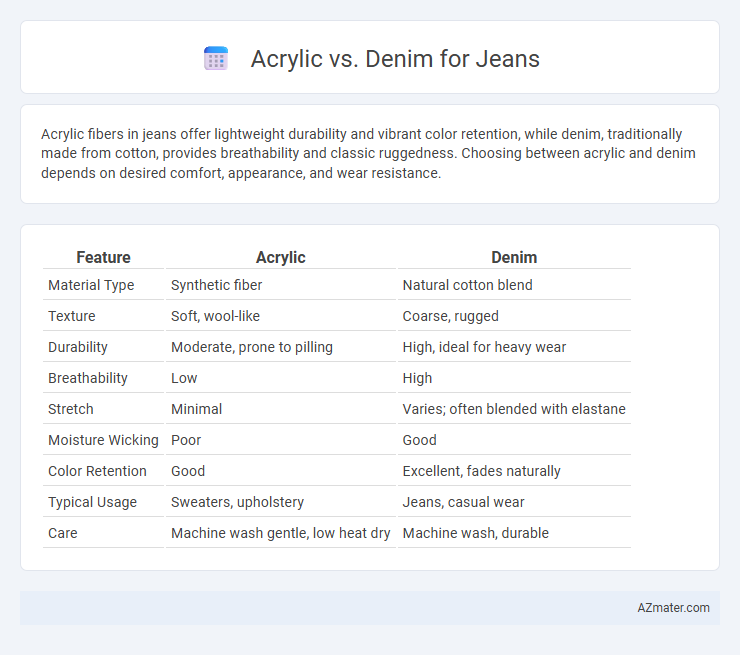Acrylic fibers in jeans offer lightweight durability and vibrant color retention, while denim, traditionally made from cotton, provides breathability and classic ruggedness. Choosing between acrylic and denim depends on desired comfort, appearance, and wear resistance.
Table of Comparison
| Feature | Acrylic | Denim |
|---|---|---|
| Material Type | Synthetic fiber | Natural cotton blend |
| Texture | Soft, wool-like | Coarse, rugged |
| Durability | Moderate, prone to pilling | High, ideal for heavy wear |
| Breathability | Low | High |
| Stretch | Minimal | Varies; often blended with elastane |
| Moisture Wicking | Poor | Good |
| Color Retention | Good | Excellent, fades naturally |
| Typical Usage | Sweaters, upholstery | Jeans, casual wear |
| Care | Machine wash gentle, low heat dry | Machine wash, durable |
Understanding Acrylic and Denim Fabrics
Acrylic fabric is a synthetic material known for its softness, warmth, and resistance to wrinkles, often used as a wool substitute, while denim is a durable cotton twill textile characterized by its diagonal ribbing and rugged texture, traditionally used for jeans. Acrylic fibers are lightweight, retain color well, and provide good insulation but lack the breathability and durability of denim. Denim's natural cotton composition offers excellent strength, comfort, and breathability, making it the preferred fabric for long-lasting, sturdy jeans.
Key Differences Between Acrylic and Denim
Acrylic is a synthetic fiber known for its lightweight, wool-like texture and resistance to moisture, making it less breathable compared to denim, which is a durable, woven cotton fabric prized for its strength and comfort. Denim's natural fibers allow better air circulation and durability under heavy wear, whereas acrylic tends to retain heat and can be less resistant to abrasion. In terms of maintenance, denim usually becomes softer and more comfortable with washing, while acrylic may pill or lose shape over time.
Durability: Acrylic vs Denim in Jeans
Denim is known for its exceptional durability in jeans, made from tightly woven cotton twill that withstands wear and tear over time. Acrylic fibers, often used for softness and elasticity in blended fabrics, lack the robust strength to endure heavy use compared to denim. When choosing jeans for long-lasting wear, denim remains the superior fabric due to its resistance to abrasion and structural integrity.
Comfort and Wearability Comparison
Acrylic jeans offer lightweight warmth and a soft texture, enhancing comfort in cooler weather, but may lack breathability compared to denim. Denim provides superior durability and better moisture absorption, contributing to long-term wearability and comfort in various conditions. Stretch denim blends improve flexibility and fit, making them more comfortable for active wear compared to acrylic-based jeans.
Breathability and Moisture Management
Denim, made from tightly woven cotton fibers, offers moderate breathability but tends to retain moisture longer, making it less effective for moisture management compared to acrylic blends. Acrylic fabrics are synthetic and designed to wick moisture away from the skin, enhancing ventilation and keeping the wearer dry during extended wear. When choosing between acrylic and denim for jeans, denim provides durability and traditional comfort, while acrylic excels in breathability and moisture control for active or warm environments.
Maintenance and Cleaning Tips
Acrylic jeans require gentle washing in cold water to prevent fabric damage and maintain softness, while denim jeans benefit from infrequent washing to preserve color and shape. Use mild detergents for acrylic and avoid bleach, and for denim, turn jeans inside out before washing to reduce fading. Air drying is recommended for both fabrics to prevent shrinkage and maintain durability.
Environmental Impact: Which is Greener?
Acrylic textiles contribute significantly to environmental pollution due to their synthetic origin, relying on petrochemicals that emit greenhouse gases during production and are non-biodegradable, leading to microplastic pollution in oceans. Denim, made primarily from cotton, has a high water and pesticide footprint, but organic and sustainably produced cotton options reduce ecological harm. Choosing sustainably sourced denim with eco-friendly dyeing methods generally offers a greener alternative compared to conventional acrylic fabrics.
Style and Versatility for Jeans
Acrylic and denim offer distinct style and versatility for jeans, with denim known for its classic, rugged look and durable fabric ideal for casual and workwear styles. Acrylic fibers mimic wool's softness and warmth but lack denim's structured feel, making acrylic jeans less common and more suited for fashion-forward, softer silhouettes. Denim's ability to be dressed up or down and aged with various washes enhances its versatility, while acrylic provides vibrant color retention and a lightweight alternative for seasonal style variations.
Price Comparison: Acrylic vs Denim Jeans
Denim jeans typically cost more than acrylic jeans due to the durability and authenticity of cotton fibers used in denim fabric, which require a longer production process. Acrylic jeans are generally priced lower because acrylic fibers are synthetic and less expensive to manufacture, offering a budget-friendly alternative. Consumers often weigh the cost difference against factors like fabric quality, comfort, and longevity when choosing between acrylic and denim jeans.
Which Fabric is Best for Your Jeans?
Denim, composed primarily of cotton, offers durability, breathability, and a classic look ideal for everyday jeans, whereas acrylic, a synthetic fiber, lacks the natural comfort and strength but provides lightweight and wrinkle-resistant properties. Jeans made from denim excel in longevity and are more eco-friendly when sourced sustainably, while acrylic blends may offer stretch and color retention but often compromise on softness and breathability. When choosing the best fabric for your jeans, prioritize denim for traditional wear and durability, and consider acrylic blends only for specific style or lightweight needs.

Infographic: Acrylic vs Denim for Jean
 azmater.com
azmater.com